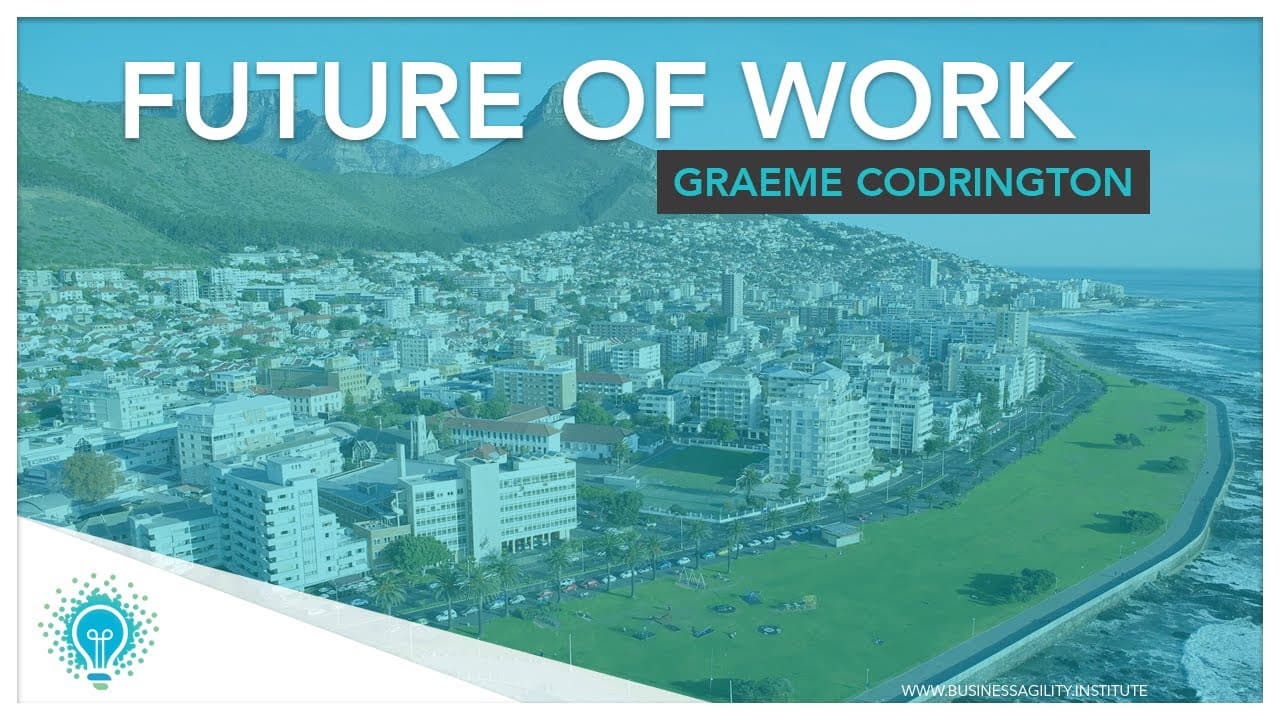Now that you've got a sense from Evan of what the landscape is for the next two days, you're obviously going to drill down into each part of that landscape that he showed you in business agility. My task is to make sure that you don't stick with incremental thinking as you get going.
I'm not here to give you another list of what might happen in the future. As you've heard, business agility doesn't set a pathway that says, "Here's the path, there's the place you've got to go to." It gives you tools to get there. One of the biggest tools you have is not merely improving what you've already got but stepping back and reimagining what could be.
If you reverse-engineer your business from the future—put yourself ten or twenty years ahead and imagine what a company in your industry will need to look like—then work backward to what you can do now to move in that direction, I think that will set you up in a much better mindset than starting from the past. In other words, instead of thinking, "This is what we've got now, how do we tweak it to take another step?" you shift your perspective. It might sound like a simple consultant’s trick to change the frame from the future rather than the past, but I honestly believe it will make all the difference.
The Fourth Industrial Revolution
Let me show you how to do it and set you up so that, as you listen to the presentations over the next two days, you're using this future-of-work mindset. Now, this is the slide that is meant to get at least half of you rolling your eyes, because every conference you've been to in the last two years has had speakers talking about the Fourth Industrial Revolution.
This phrase, coined at the World Economic Forum in Davos about three years ago, has quickly become a cliché. I've been to conferences where every second workshop is about it. I did scan the program for the next two days, and I’m glad to see that it’s conspicuously absent here. However, despite its overuse, I still think it's worth considering what this so-called Fourth Industrial Revolution really is.
I'm absolutely certain that Cyril Ramaphosa will use this phrase again in his State of the Nation address—either that or "work under" again. It’s one of those phrases that can cover up a complete lack of actually knowing what you're talking about. If you go to a conference and see a speaker discussing the Fourth Industrial Revolution, be a little cheeky. Go up to them and ask, "I'm just checking if I should come to your session. You're talking about the Fourth Industrial Revolution, right? What was the second one?" If they can’t answer that, you should probably skip the session.
A Quick History of Industrial Revolutions
The First Industrial Revolution began in 1712 when an Englishman named Thomas Newcomen invented the steam-driven pump. It was first used in a Welsh coal mine to remove water, allowing miners to dig deeper and extract more coal. Within a few decades, steam-driven technology spread across industries, from clothing manufacturing to book printing, hospitals to transportation. No industry was left untouched. It was all remarkable—except for the smog.
When you studied this in school, you probably just called it the "Industrial Revolution" without realizing it was the first.
The Second Industrial Revolution began in the late 1800s, driven by two major factors. The first was productivity improvement, best exemplified by Henry Ford's motor factory. By 1922, Ford had perfected a continuous production line that produced a car every 32 seconds.
The second driver was a new concept of human management—scientific management, pioneered by Frederick Taylor. Ford himself had a moment of realization when he thought, "People who make our cars should be able to afford to buy them." So, he doubled wages overnight. But instead of simply handing out cash, he introduced car financing, allowing employees to buy the cars they built. This was a mindset shift in management.
Here’s the key takeaway: The Second Industrial Revolution was not about inventing new technologies. It was about taking existing technologies and reimagining the world of work based on them.
The Third and Fourth Industrial Revolutions
The Third Industrial Revolution? Computing and IT. From mainframes to desktops, laptops, smartphones, and now integrated systems. From dial-up to fiber optics. The digital revolution.
Now, the Fourth Industrial Revolution—this mythical, magical concept—supposedly changes everything. But what is it really? AI? Machine learning? Automation? That’s what most people say in Fourth Industrial Revolution workshops. But they're wrong.
The Fourth Industrial Revolution is not about new technologies. I gave you the answer earlier. The Fourth Industrial Revolution is taking the technologies that exist and reimagining how we work using them. You don’t need Google-level artificial intelligence or basement-sized supercomputers. You already have more computing power in your smartphone than NASA had 20 years ago.
Reimagining Business in the Digital Age
Most businesses have spent the last decade improving the speed and cost of what they were already doing. They haven’t taken a blank piece of paper and asked, "Now that we live in a digital age, what should we actually be doing?"
Let’s take healthcare as an example. Right now, we don’t have a healthcare system—we have a sick care system. You only enter the system when you’re already sick. But what if we reimagined it?
Imagine if, one week before you got sick, your doctor contacted you and said, "Hey, you’re about to get sick. Here’s how to stop it." Is that possible? Absolutely. We already have fitness trackers. The next generation will include blood pressure, body temperature, and more. Imagine feeding that data into a system where your doctor—or, more accurately, a supercomputer in your doctor's office—could predict illnesses before they happen.
What if we changed the incentive model? Instead of paying doctors when we are sick, we pay them for every healthy month we have. Suddenly, doctors would be motivated to keep us well instead of just treating us when we're ill.
The Future of Business Agility
Business agility is about putting the customer at the center. It’s about being proactive, predictive, and preventative. It’s about reimagining the world of work rather than just tweaking the past.
If you get to the end of this conference and all you've done is make your business slightly cheaper, better, or faster, then you will have missed the point. This conference is about reimagination—about jumping into the future and preparing to completely rethink every function, process, and strategy in your business.
As Evan said, there isn’t a roadmap. But if you take the model he presented and apply this mindset of reimagination, you can set yourself up to think about your business in fundamentally new ways.
The 2020s are here. This isn’t the future anymore—we are living in it. The greatest danger we face isn’t the turbulence of the world around us. The greatest danger is using yesterday’s logic for tomorrow’s world.
The 2020s are an invitation to reimagine.
Thank you.



